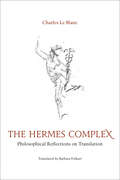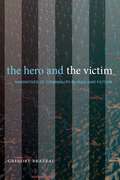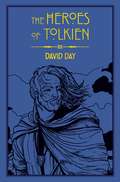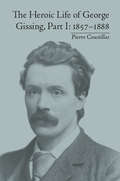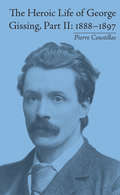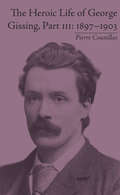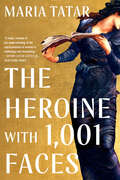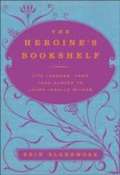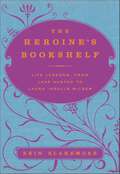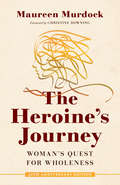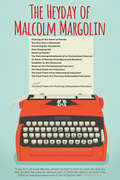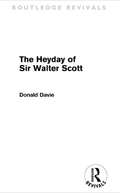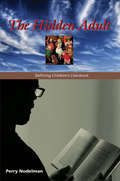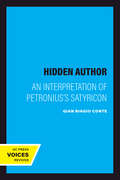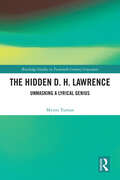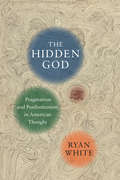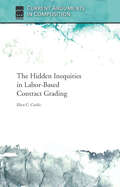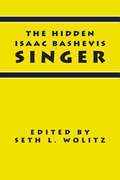- Table View
- List View
The Hermes Complex: Philosophical Reflections on Translation (Perspectives on Translation)
by Charles Le BlancWhen Hermes handed over to Apollo his finest invention, the lyre, in exchange for promotion to the status of messenger of the gods, he relinquished the creativity that gave life to his words.The trade-off proved frustrating: Hermes chafed under the obligation to deliver the ideas and words of others and resorted to all manner of ruses in order to assert his presence in the messages he transmitted. His theorizing descendants, too, allow their pretentions to creatorship to interfere with the actual business of reinventing originals in another language.Just as the Hermes of old delighted in leading the traveller astray, so his descendants lead their acolytes, through thickets of jargon, into labyrinths of eloquence without substance.Charles Le Blanc possesses the philosophical tools to dismantle this empty eloquence: he exposes the inconsistencies, internal contradictions, misreadings, and misunderstandings rife in so much of the current academic discourse en translation, and traces the failings of this discourse back to its roots in the anguish of having traded authentic creativity for mere status.
The Hero Is You: Sharpen Your Focus, Conquer Your Demons, and Become the Writer You Were Born to Be (Open Center Book Ser.)
by Kendra LevinConquer writer&’s block, love what you write, and finish what you start with this motivational self-care book for writers. Imagine having your own personal mentor—someone encouraging yet honest, who could help you set and achieve your goals, turn your moments of doubt and fear into sources of strength, and discover what you&’re truly capable of when you&’re at your best. Life coach and publishing industry veteran Kendra Levin is that mentor. And in The Hero Is You, she can help you do the best writing of your life—and live your best life while doing it. With wisdom drawn from her years as a life coach for writers and behind-the-scenes stories from a panoply of bestselling authors, Levin shows you how to become the hero in the narrative of your own process. Offering a fresh approach to Joseph Campbell&’s storytelling archetype, the Hero&’s Journey, The Hero Is You includes more than thirty exercises designed to help you reinvent your creative process from the inside out. This book will show you how to: Identify your biggest challenges and render them powerlessStart a project that you love—and stick with itDesign a structure for writing regularly
The Hero and the Victim: Narratives of Criminality in Iraq War Fiction
by Gregory BrazealTwo decades after the US invasion of Iraq in 2003, a canon of American literature about the war has begun to emerge. Gregory Brazeal’s The Hero and the Victim situates Iraq War fiction in war literature’s broader history. In contrast to the emphasis of most pre-modern war literature on the figure of the warrior-as-hero, and the growing modern emphasis on the figure of the soldier-as-victim, Iraq War fiction reflects the troubled emergence of a new narrative: the story of the ordinary soldier as a wrongdoer or even criminal. To a greater extent than earlier literature about American wars, Iraq War fiction is haunted by depictions of moral injury and expressions of unresolved guilt. The emphasis on soldier criminality in Iraq War fiction can be partly explained by the rise of moral cosmopolitanism and its blurring of the traditional conceptual lines between war and crime. The anti-war literature of the twentieth century often presented fallen soldiers on both sides equally as victims and viewed the distinction between heroes and villains as part of the illusion that battlefield experience strips away. Written in the long shadow of Nuremberg, Iraq War fiction grapples with the possibility that the soldiers on one’s own side may not be the heroes in the story, or even the victims, but participants in a wrong, and perhaps even complicit in crimes. The Hero and the Victim contributes to the ongoing, public reexamination of American traditions by confronting a topic that has, up to now, been largely untouched: the moral celebration of military service. The Hero and the Victim explores the theme of soldier criminality through close readings of several works by American authors, including Kevin Powers’s The Yellow Birds, Phil Klay’s Redeployment, Helen Benedict’s Sand Queen, Chris Kyle’s American Sniper, and Roy Scranton’s War Porn. This volume will be an essential text for students of American literature, historians of war culture, and any scholar interested in representations of the Iraq War.
The Heroes of Tolkien: An Exploration of Tolkien's Heroic Characters, and the Sources that Inspired his Work from Myth, Literature and History
by David DayTolkien's Middle-earth has endured cataclysmic wars and critical battles, causing great men and women to arise and shape the course of its history. In his latest book, best-selling author and Tolkien expert David Day examines the complexities surrounding Tolkien's portrayal of good and evil, analysing the most celebrated heroes from the creation of the world of Arda until the end of the War of the Rings.This work is unofficial and is not authorized by the Tolkien Estate or HarperCollins Publishers.
The Heroes of Tolkien: An Exploration of Tolkien's Heroic Characters, and the Sources that Inspired his Work from Myth, Literature and History (Tolkien)
by David DayIn J. R. R Tolkien's Lord of the Rings, The Hobbit and The Silmarillion, Middle-earth endured cataclysmic wars and critical battles, causing great men, women and mystical creatures to arise, influence and shape the course of its history. Here in this book, Tolkien expert David Day examines the complexities surrounding Tolkien's portrayal of good and evil, and analyses Middle-earth's most celebrated heroes and the literary, historical and mythological sources that inspired their creation.This work is unofficial and is not authorized by the Tolkien Estate or HarperCollins Publishers.
The Heroic Life of George Gissing, Part I: 1857–1888 (The Heroic Life of George Gissing)
by Pierre CoustillasThis ambitious three-volume biography on Gissing examines both his life and writing chronologically and in close detail. Part I covers Gissing’s early life up until his establishment as a writer of moderate critical success.
The Heroic Life of George Gissing, Part II: 1888–1897 (The Heroic Life of George Gissing)
by Pierre CoustillasThis ambitious three-volume biography on Gissing examines both his life and writing both chronologically and in close detail. Part II assesses the period of Gissing’s greatest authorial triumphs. His most critically acclaimed works, The Nether World (1889), New Grub Street (1891) and The Odd Women (1893) date from this time.
The Heroic Life of George Gissing, Part III: 1897–1903 (The Heroic Life of George Gissing)
by Pierre CoustillasThis ambitious three-volume biography on Gissing examines both his life and writing both chronologically and in close detail. This final volume in Coustillas’s prodigious biography examines the turbulent last years of the author’s life and his literary afterlife.
The Heroic Temper: Studies in Sophoclean Tragedy (Sather Classical Lectures #35)
by Bernard M. KnoxThe first two chapters of this book isolate and describe the literary phenomenon of the Sophoclean tragic hero. In all but one of the extant Sophoclean dramas, a heroic figure who is compounded of the same literary elements faced a situation which is essentially the same. The demonstration of this recurrent pattern is made not through character-analysis, but through a close examination of the language employed by both the hero and those with whom he contends. The two chapters attempt to present what might, with a slight exaggeration, be called the "formula" of Sophoclean tragedy.A great artist may repeat a structural pattern but he never really repeats himself. In the remaining four chapters, a close analysis of three plays, the Antigone, Philoctetes, and Oedipus at Colonus, emphasizes the individuality and variety of the living figures Sophocles created on the same basic armature. This approach to Sophoclean drama is (as in the author's previous work on the subject) both historical and critical; the universal and therefore contemporary appeal of the plays is to be found not by slighting or dismissing their historical context, but by an attempt to understand it all in its complexity. "The play needs to be seen as what it was, to be understood as what it is."
The Heroine with 1001 Faces
by Maria TatarWorld-renowned folklorist Maria Tatar reveals an astonishing but long-buried history of heroines, taking us from Cassandra and Scheherazade to Nancy Drew and Wonder Woman. The Heroine with 1,001 Faces dismantles the cult of warrior heroes, revealing a secret history of heroinism at the very heart of our collective cultural imagination. Maria Tatar, a leading authority on fairy tales and folklore, explores how heroines, rarely wielding a sword and often deprived of a pen, have flown beneath the radar even as they have been bent on redemptive missions. Deploying the domestic crafts and using words as weapons, they have found ways to survive assaults and rescue others from harm, all while repairing the fraying edges in the fabric of their social worlds. Like the tongueless Philomela, who spins the tale of her rape into a tapestry, or Arachne, who portrays the misdeeds of the gods, they have discovered instruments for securing fairness in the storytelling circles where so-called women’s work—spinning, mending, and weaving—is carried out. Tatar challenges the canonical models of heroism in Joseph Campbell’s The Hero with a Thousand Faces, with their male-centric emphases on achieving glory and immortality. Finding the women missing from his account and defining their own heroic trajectories is no easy task, for Campbell created the playbook for Hollywood directors. Audiences around the world have willingly surrendered to the lure of quest narratives and charismatic heroes. Whether in the form of Frodo, Luke Skywalker, or Harry Potter, Campbell’s archetypical hero has dominated more than the box office. In a broad-ranging volume that moves with ease from the local to the global, Tatar demonstrates how our new heroines wear their curiosity as a badge of honor rather than a mark of shame, and how their “mischief making” evidences compassion and concern. From Bluebeard’s wife to Nancy Drew, and from Jane Eyre to Janie Crawford, women have long crafted stories to broadcast offenses in the pursuit of social justice. Girls, too, have now precociously stepped up to the plate, with Hermione Granger, Katniss Everdeen, and Starr Carter as trickster figures enacting their own forms of extrajudicial justice. Their quests may not take the traditional form of a “hero’s journey,” but they reveal the value of courage, defiance, and, above all, care. “By turns dazzling and chilling” (Ruth Franklin), The Heroine with 1,001 Faces creates a luminous arc that takes us from ancient times to the present day. It casts an unusually wide net, expanding the canon and thinking capaciously in global terms, breaking down the boundaries of genre, and displaying a sovereign command of cultural context. This, then, is a historic volume that informs our present and its newfound investment in empathy and social justice like no other work of recent cultural history.
The Heroine's Bookshelf: Life Lessons, from Jane Austen to Laura Ingalls Wilder
by Erin BlakemoreIn this compelling book of beloved heroines and the remarkable writers who created them, Blakemore explores how the pluck and dignity of literary characters such as Scout Finch and Jo March can inspire women today.
The Heroine's Bookshelf: Life Lessons, from Jane Austen to Laura Ingalls Wilder
by Erin BlakemoreA testament to inspirational women throughout literature, Erin Blakemore’s exploration of classic heroines and their equally admirable authors shows today’s women how to best tap into their inner strengths and live life with intelligence, grace, vitality and aplomb. This collection of unforgettable characters—including Anne Shirley, Jo March, Scarlett O’Hara, and Jane Eyre—and outstanding authors—like Jane Austen, Harper Lee, and Laura Ingalls Wilder—is an impassioned look at literature’s most compelling heroines, both on the page and off. Readers who found inspiration in books by Toni Morrison, Maud Hart Lovelace, Ursula K. LeGuin, and Alice Walker, or who were moved by literary-themed memoirs like Shelf Discovery and Everything I Needed to Know About Being a Girl I Learned from Judy Blume, get ready to return to the well of women’s classic literature with The Heroine's Bookshelf.
The Heroine's Journey: Woman's Quest for Wholeness
by Maureen MurdockThis book describes contemporary woman's search for wholeness in a society in which she has been defined according to masculine values. Drawing upon cultural myths and fairy tales, ancient symbols and goddesses, and the dreams of contemporary women, Murdock illustrates the need for—and the reality of—feminine values in Western culture today.
The Hesiodic Catalogue of Women and Archaic Greece
by Kirk OrmandThis book examines the extant fragments of the archaic Greek poem known in antiquity as Hesiod's Catalogue of Women. Kirk Ormand shows that the poem should be read intertextually with other hexameter poetry from the eighth to sixth century BCE, especially Homer, Hesiod, and the Cyclic epics. Through literary interaction with these poems, the Catalogue reflects political and social tensions in the archaic period regarding the production of elite status. In particular, Ormand argues that the Catalogue reacts against the "middling ideology" that came to the fore during the archaic period in Greece, championing traditional aristocratic modes of status. Ormand maintains that the poem's presentation of the end of the heroic age is a reflection of a declining emphasis on nobility of birth in the structures of authority in the emerging sixth century polis.
The Heyday of Malcolm Margolin: The Damn Good Times of a Fiercely Independent Publisher
by Kim BancroftIn an age of big box stores and media conglomerates, how can an independent publishing house survive—and even thrive? Kim Bancroft takes us into Heyday, a small press that for forty years has spotlighted California's best stories. Drawing from the words of founder Malcolm Margolin, this compelling portrait recounts the making of Heyday, from its roots in the do-it-yourself/change-the-world clime of 1970s Berkeley to its present-day status as the “cultural linchpin for the state” (Northern California Book Booksellers Association). A chorus of friends, including Maxine Hong Kingston, Robert Hass, and Kevin Starr, enriches our understanding of a vibrant literary community and its one-of-a-kind leader. Funny and provocative, The Heyday of Malcolm Margolin reveals the workings of a courageously unconventional enterprise run on beauty, passion, friendship, and joy.
The Heyday of Sir Walter Scott (Routledge Revivals)
by Donald DavieFirst published in 1961, this book examines a number of works popular in the Romantic period, during the heyday of Sir Walter Scott in the early part of the nineteenth century. Encompassing works by the likes of Alexander Pushkin, Sir Walter Scott, Adam Mickiewicz and James Fenimore Cooper, this is also a meditation on the nature of Romanticism and its enduring value, as expressed in the novel form. Donald Davie also considers the meaning and importance of ‘plot’ and of ‘realism’.
The Hidden Adult: Defining Children's Literature
by Perry NodelmanWhat exactly is a children’s book? How is children’s literature defined as a genre? A leading scholar presents close readings of six classic stories to answer these questions and offer a clear definition of children’s writing as a distinct literary form. Perry Nodelman begins by considering the plots, themes, and structures of six works: "The Purple Jar," Alice in Wonderland, Dr. Doolittle, Henry Huggins, The Snowy Day, and Plain City—all written for young people of varying ages in different times and places—to identify shared characteristics. He points out markers in each work that allow the adult reader to understand it as a children’s story, shedding light on ingrained adult assumptions and revealing the ways in which adult knowledge and experience remain hidden in apparently simple and innocent texts.Nodelman then engages a wide range of views of children's literature from authors, literary critics, cultural theorists, and specialists in education and information sciences. Through this informed dialogue, Nodelman develops a comprehensive theory of children's literature, exploring its commonalities and shared themes. The Hidden Adult is a focused and sophisticated analysis of children’s literature and a major contribution to the theory and criticism of the genre.
The Hidden Author: An Interpretation of Petronius's Satyricon (Sather Classical Lectures #60)
by Gian Biagio ConteThe Satyricon of Petronius, a comic novel written in the first century A.D., is famous today primarily for its amazing banquet tale, "Trimalchio's Feast." But this episode is only one part of the larger picture of life during Nero's rule presented in the work. In this accessible discussion of Petronius's masterful use of parody, Gian Biagio Conte offers an interpretation of the Satyricon as a whole. He combines the scholarly precision of close reading with a significant, original theoretical model.At the heart of his interpretation, Conte reveals the technique of the "hidden author" that Petronius employs at the expense of his characters, in particular the teller of the story, Enclopius. By remaining hidden outside the narrative, Petronius invites the reader to smile at the folies de grandeur that occur in a culture of scholars and declaimers. Yet as Conte shows, behind the parody and inexhaustible humor of the Satyricon lies an unexpectedly serious lament. For those familiar with the Satyricon, as well as for new readers, Conte's book will be a reliable, enjoyable guide to the wonders the Satyricon contains.
The Hidden D. H. Lawrence: Unmasking a Lyrical Genius (Routledge Studies in Twentieth-Century Literature)
by Myron TumanThe Hidden D. H. Lawrence is a new study of the psychological and literary aspects of a great writer’s lyrical genius. It explores how Lawrence, when writing on his favorite subject, the relations between men and women, moved so quickly between heavy-handed exposition and deeply inspired prose, depending on the gender of the object of his attention. Nowhere is this clearer than in the three grand love scenes from Lady Chatterley’s Lover, those cut from the first American edition of 1932. In these scenes, Mellors, Lawrence’s usual alter ego, suddenly and almost magically becomes the object of attention, although now seen through the eyes of his female protagonist. It may seem as if Lawrence’s purpose here is to probe a woman’s psyche, until one realizes that it is only such moments—when his focus seems less on his female character than the erotic allure of a powerful man—that unlock Lawrence’s lyrical genius. The claim here is that in his major novels and stories, Lawrence was less interested in exploring the emotional lives of women than in using his female characters (as well as many sensitive male protagonists) to explore his own psychic life, one marked by the persistent attraction to the image of a strong male—an inner life that for the last century has been hiding in plain sight.
The Hidden God
by Ryan WhiteThe Hidden God revisits the origins of American pragmatism and finds a nascent "posthumanist" critique shaping early modern thought. By reaching as far back as the Calvinist arguments of the American Puritans and their struggle to know a "hidden God," this book extends the parameters of intellectual history to bring American pragmatism closer to contemporary critical theory.The study reads the writings of key American philosophers, including Jonathan Edwards, Ralph Waldo Emerson, William James, and Charles Sanders Peirce, against modern theoretical works by Niklas Luhmann, Richard Rorty, Jacques Derrida, Sharon Cameron, Cary Wolfe, and Gregory Bateson. This juxtaposition isolates the distinctly posthumanist form of pragmatism that began to arise in these early texts, challenging the accepted genealogy of pragmatic discourse and common definitions of posthumanist critique. Its rigorously theoretical perspective has wide implications for humanities research, enriching investigations into literature, history, politics, and art.
The Hidden God: Pragmatism and Posthumanism in American Thought
by Ryan WhiteThe Hidden God revisits the origins of American pragmatism and finds a nascent "posthumanist" critique shaping early modern thought. By reaching as far back as the Calvinist arguments of the American Puritans and their struggle to know a "hidden God," this book brings American pragmatism closer to contemporary critical theory.Ryan White reads the writings of key American philosophers, including Jonathan Edwards, Ralph Waldo Emerson, William James, and Charles Sanders Peirce, against modern theoretical works by Niklas Luhmann, Richard Rorty, Jacques Derrida, Sharon Cameron, Cary Wolfe, and Gregory Bateson. This juxtaposition isolates the distinctly posthumanist form of pragmatism that began to arise in these early texts, challenging the accepted genealogy of pragmatic discourse and common definitions of posthumanist critique. Its rigorously theoretical perspective has wide implications for humanities research, enriching investigations into literature, history, politics, and art.
The Hidden History of South Africa's Book and Reading Cultures
by Archie L. DickThe Hidden History of South Africa's Book and Reading Cultures shows how the common practice of reading can illuminate the social and political history of a culture. This ground-breaking study reveals resistance strategies in the reading and writing practices of South Africans; strategies that have been hidden until now for political reasons relating to the country's liberation struggles. By looking to records from a slave lodge, women's associations, army education units, universities, courts, libraries, prison departments, and political groups, Archie Dick exposes the key works of fiction and non-fiction, magazines, and newspapers that were read and discussed by political activists and prisoners.Uncovering the book and library schemes that elites used to regulate reading, Dick exposes incidences of intellectual fraud, book theft, censorship, and book burning. Through this innovative methodology, Dick aptly shows how South African readers used reading and books to resist unjust regimes and build community across South Africa's class and racial barriers.
The Hidden Inequities in Labor-Based Contract Grading (Current Arguments in Composition)
by Ellen C. CarilloCurrent Arguments in Composition Series The Hidden Inequities in Labor-Based Contract Grading intervenes in the increasingly popular practice of labor-based grading by expanding the scope of this assessment practice to include students who are disabled and multiply marginalized. Through the lens of disability studies, the book critiques the assumption that labor is a neutral measure by which to assess students and explores how labor-based grading contracts put certain groups of students at a disadvantage. Ellen C. Carillo offers engagement-based grading contracts as an alternative that would provide a more equitable assessment model for students of color, those with disabilities, and students who are multiply marginalized. This short book explores the history of labor-based grading contracts, reviews the scholarship on this assessment tool, highlights the ways in which it normalizes labor as an unbiased tool, and demonstrates how to extend the conversation in new and generative ways both in research and in classrooms. Carillo encourages instructors to reflect on their assessment practices by demonstrating how even assessment methods that are designed through a social-justice lens may unintentionally privilege some students over others.
The Hidden Isaac Bashevis Singer
by Seth L. WolitzNobel Prize-winning author Isaac Bashevis Singer stands virtually alone among prominent writers for being more widely known through translations of his work than through the original texts. Yet readers and critics of the Yiddish originals have long pointed out that the English versions are generally shortened, often shorn of much description and religious matter, and their perspectives and denouements are significantly altered. In short, they turn the Yiddish author into a Jewish-American English writer, detached from of his Eastern European Jewish literary and cultural roots.
The Hidden Jane Austen
by John WiltshireIn this major study, leading Austen scholar John Wiltshire offers new interpretations of Jane Austen's six novels, Sense and Sensibility (1811), Pride and Prejudice (1813), Mansfield Park (1814), Emma (1816), Northanger Abbey and Persuasion (1818). Much recent criticism of Austen has concentrated on the social, historical and intellectual context of her work, but Wiltshire turns attention back to Austen's prose techniques. Arguing that each of Austen's works has its own distinct focus and underlying agenda, he shows how Austen's interest in psychology, and especially her treatment of attention and the various forms of memory, helped shape her narratives. Through a series of compelling close readings of key passages in each novel, Wiltshire underscores Austen's unique ability to penetrate the hidden inner motives and impulses of her characters, and reveals some of the secrets of her narrative art.
